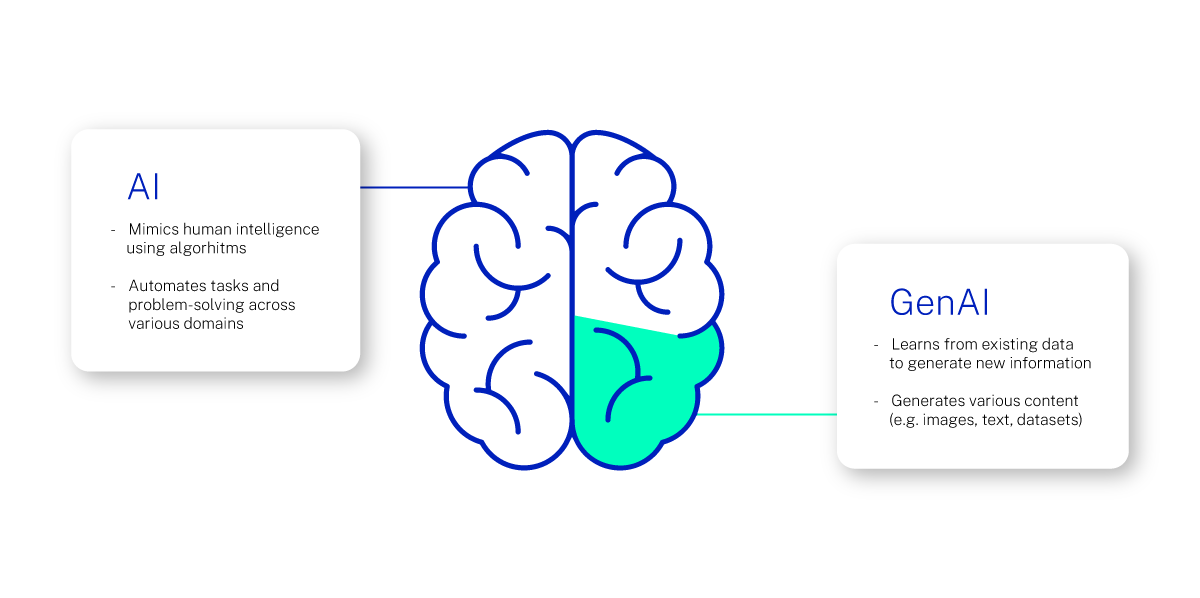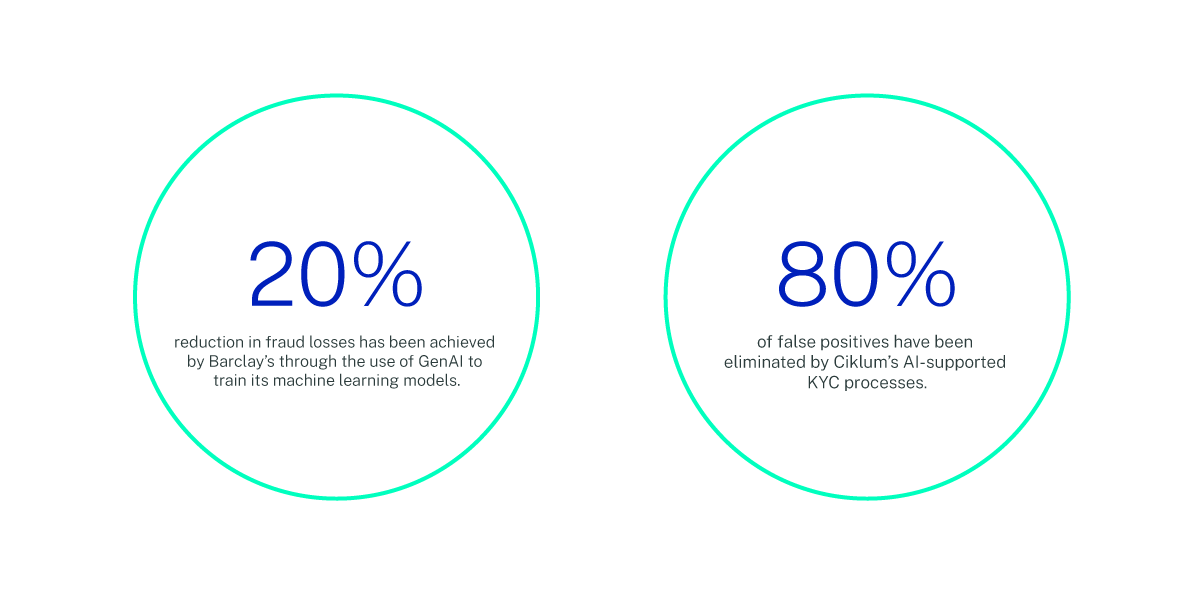Generative AI (GenAI) tools are transforming businesses in just about every sector you can think of - and generative AI in finance is certainly no exception.
Artificial Intelligence (AI) encompasses a wide range of technologies that simulate human intelligence, aiming to streamline processes, maximize efficiency, and optimize resource utilization across various industries. On the other hand, GenAI is a subset of AI that focuses on creating new content, often indistinguishable from human-generated content. GenAI introduces a creative dimension, generating content such as images, text, or entire datasets.

Forward-thinking organizations that are embracing this emerging, intelligent technology are finding new ways to maximize revenue, get more done with less, and save valuable employee time so they can focus on tasks where human skills are more in demand. But for financial services firms specifically, one area where generative AI is making a real difference - especially in the current business landscape - is in mitigating and reducing risk. This is evident across various applications including fraud detection, credit risk assessments, market risk analysis and cybersecurity threat detection, just to name a few.
This blog explores the scale of the opportunities that surround generative AI in finance, and some of the generative AI tools you can use to take full advantage. We’ll explore some of the real-world examples of how GenAI is being used, some of the key areas in which it can mitigate risk, and how bringing in third-party expertise can help you overcome key challenges and concerns.
How is generative AI used?
Firstly, it’s important to differentiate between AI in general, and generative AI specifically. AI is used to make decisions and processes faster, easier, more efficient and cost-effective; from the perspective of financial services, this would be for things like credit scoring, compliance, fraud detection and reconciliation. Gen AI, on the other hand, is used for producing content, ideas and answers to questions, so can be used for drafting contracts, financial scenarios, business intelligence and report generations.
These two types of intelligence can converge to support a range of valuable use cases for financial services firms. For example, AI-backed processing of finance data can come together with report and scenario generation to support detailed, data-driven demand forecasting. Similar principles can also apply to recommendation engines, audit risk detection, and to wider data-based insights more generally.
Many of the AI and generative AI tools mentioned here are already widely used in the sector, and their use is becoming more commonplace all the time. But the opportunities afforded by the convergence of the two types of intelligence are relatively unexplored, which is where forward-thinking firms stand to drive meaningful competitive advantage.
How can generative AI tools help mitigate risk?
One of the most important areas where generative AI tools can make a real difference to financial services firms is in risk mitigation. Risk has never been a more important factor for the sector to consider, and that’s for a variety of reasons. These include, and are by no means limited to: increased regulation around finance and data; stronger penalties for non-compliance; the rising threat and sophistication of cybercrime; and the reputational damage that disruption can have on a brand.
For these reasons and more, every financial services business has to take whatever steps it can to mitigate risk. However, these measures can often be expensive, inefficient and time-consuming, with knock-on implications on productivity, revenue and profitability. This is where generative AI can be so handy, in particular in these three areas:
 Fraud detection
Fraud detection
It might sound strange at first glance, but generative AI can help with fraud detection functions and strategies by pretending to be a fraudster itself.
GenAI can generate examples of fraudulent transactions that can then be used by machine learning algorithms to learn some of the typical characteristics of these illegitimate activities. That way, when real fraudulent activity comes along, the algorithms are far more capable of spotting the suspicious activity, and taking steps to block the transaction and/or alert relevant employees to take further action.
The obvious benefit here is to prevent the financial loss of fraud, but the positives of detection supported by generative AI go much further than that. The security and integrity of operations can be improved, without the need for huge investment in extra human resources, and the trust of customers and consumers can be maintained.
Many major banking institutions are deploying these strategies to good effect; Barclays’ use of GenAI to train its machine learning models has reduced its fraud losses by 20%. And we have been able to develop our own AI-supported KYC processes that have helped eliminate 80% of false positives.

 Financial loss prevention
Financial loss prevention
Every financial services business is at risk of financial loss at some point or another. This can be for self-inflicted reasons that stem from poor decision-making, or from prevailing market conditions beyond the organization's control but that still lead to losses. Either way, all actions that can be taken to stem these losses and protect financial interests are vital to the business’s viability.
One way in which generative AI helps in this area is through portfolio optimization. GenAI can run through huge volumes of historical data, and use that to generate a range of different scenarios based on various investment decisions. These can be varied depending on market conditions, wider economic environments, and any potential unforeseen events that may also have a destabilizing effect.
The result of this is that key decision-makers like asset managers and senior wealth management officials can make the big calls with confidence that they’re the right ones. They can make investments with much more detailed knowledge of the scale of potential risk, and the scale of the returns that they could make. This means that more successful and more resilient investment strategies can be built for the long-term, and the number of ‘failed’ investments can be vastly reduced.
 Customer satisfaction improvement
Customer satisfaction improvement
The views of the customer base and of the wider public are critical to the success of a financial institution these days. In the age of social media, even the smallest error or disruption can quickly be amplified to a wider audience and cause huge brand damage. Similarly, people are far more aware of the need to keep finances and data digitally secure than they have been in the past, and so their expectations of their financial providers have risen significantly.
The act of security - through measures like the fraud prevention measured above - is only half the battle here. Customers increasingly want to know what is going on, and what steps are being taken to protect their finances. Generative AI can help here through proactively warning customers about fraudulent activity, and through education that encourages safer practice while shopping online. As an example, HSBC has used the technology to generate personalized alerts that make customers aware of potentially fraudulent transactions. Additionally, we have seen first hand the positive effects it can have in financial crime reporting, identifying and closing 95% of alerts that turn out to be unimportant, resulting in a time saving of 50%.
Unlocking the potential of generative AI tools
Every new technology brings with it a balance of risk and reward. Somewhat ironically in this case, the reward can be the reduction of risk in a fast-changing financial services marketplace. The risk in technology deployment terms is making an investment into a generative AI solution that isn’t suited to the specific needs and objectives of your organization. However, these three strategies can all help ensure that such a scenario is avoided:
 Collaborate with experts
Collaborate with experts
Generative AI is not an endeavor that you have to pursue on your own. Indeed, the technology is so advanced and is progressing at such a rapid rate that it’s probably best not to go it alone, unless you happen to have some highly skilled AI expertise in-house.
The best way forward is to work with an expert partner that understands the technology, and has the insight on how to apply it for financial services specifically. That partner can not only work closely with your IT team, but also your CFO so that they can understand the practical benefits of applying generative AI in the right places. That way, GenAI can not only increase satisfaction and improve experiences, but enable the creation of new financial processes - and the improvement of current ones - to adapt to changing client demands.
 Understand the purpose of AI
Understand the purpose of AI
That partner can also help you identify how, why and where generative AI should be deployed to your processes and functions. This starts with a discovery process where that partner assesses how you run things at present, and looks for opportunities to put automation in place. From this, GenAI deployments can be designed and deployed for best effect, so that the benefits of time saving, resource saving and cost efficiency can be maximized.
 Foresee and resolve risks
Foresee and resolve risks
It's crucial to acknowledge that, like any technology, generative AI in finance comes with its own set of limitations and ethical considerations. Balancing technological innovation with ethical practices is key to ensuring a responsible and sustainable integration.
CFOs will naturally have a number of concerns about deploying generative AI; after all, it represents a major departure from the way that many essential processes have run for years or even decades. These concerns can include data security, privacy, compliance, algorithm bias, change management, scalability over time, and how the wider use of AI will be perceived by the human workforce.
All of these are valid points to raise, and this is where choosing the right partner can make such a big difference. They will have the knowledge and the expertise to address these points in turn, show how generative AI can be used securely and ethically; and be able to advise on change management that encourages positive buy-in from existing employees.
In summary: embracing the change of generative AI in finance
While generative AI is relatively new technology, it’s becoming increasingly clear that it isn’t going away. Salesforce research has found that 73% of the population of India is already using GenAI in some way, while the figures for Australia and the United States are just below 50%. So while some CFOs may be hesitant to explore all the possibilities that generative AI has to offer, those that wait too long will be punished severely as their organization loses out to competitors on multiple fronts.
So now is the time to get on board and make the most of generative AI in cutting risk and setting your organization up for growth, scale and prosperity, whatever the future might hold. That way, you can explore detailed assessments, personalized strategy development and phased implementations to ensure smooth transitions and take full advantage.
The first step on that journey is to team up with an expert partner in GenAI, and with our leading innovation and global workforce, Ciklum is the right partner for you. Get in touch with our team today for an informal, no-obligation chat on how we can support you with your specific objectives.
Blogs


































